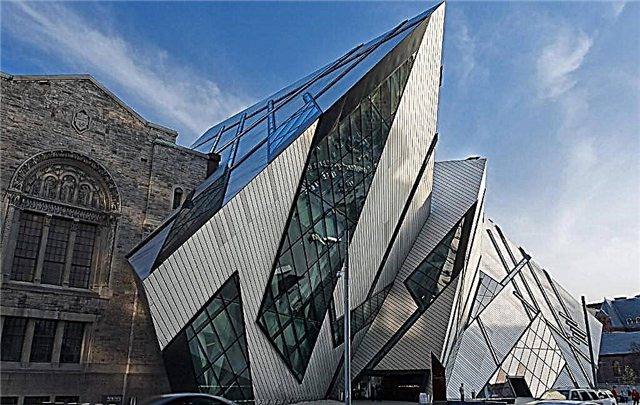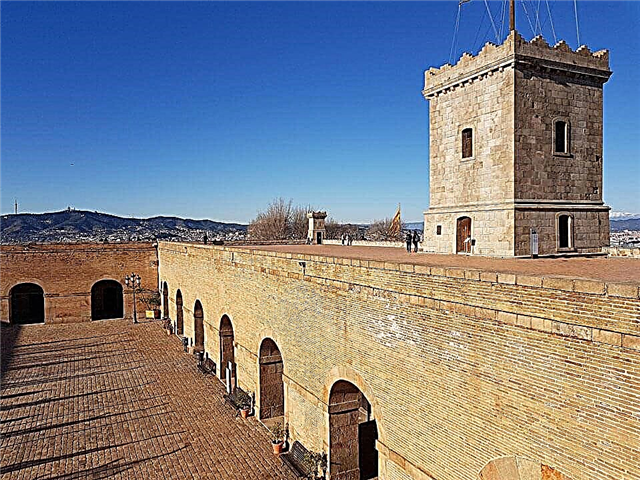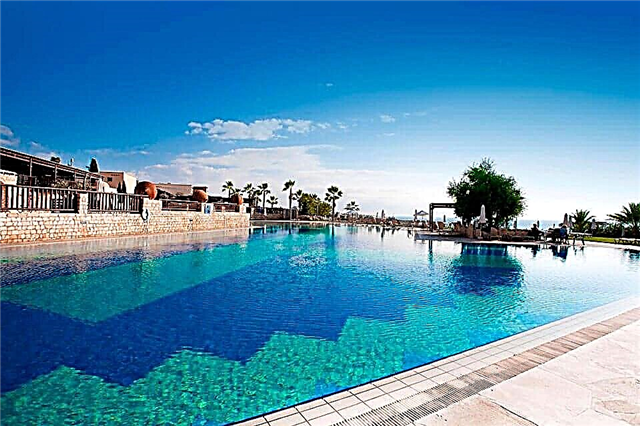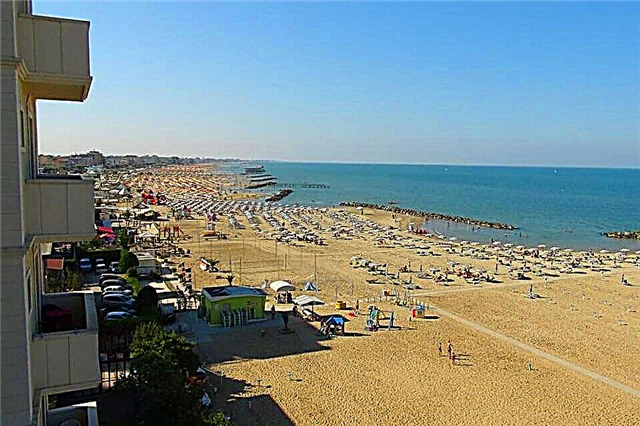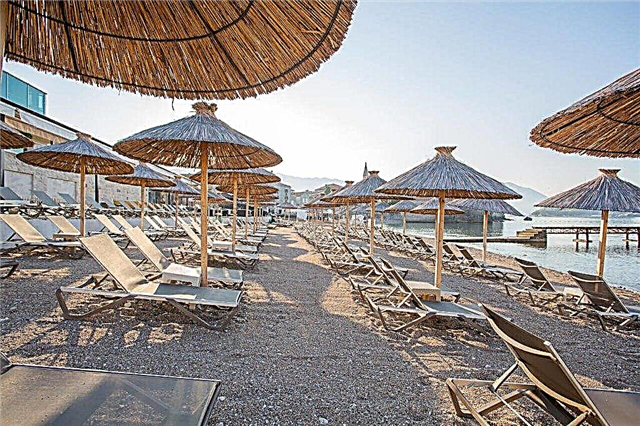Budva not only positions itself, but is really the pearl of seaside Montenegro - cultural, historical, tourist and simply aesthetic. The visiting card of this place is the natural beauty of the landscapes, crowned with dense greenery and deep aquamarine, against the background of which the capillaries of ancient heavy or, on the contrary, surprisingly fragile buildings shine through even more brightly. A visit to this city cannot leave you completely indifferent - these, as if drawn, city pages are surprisingly in harmony with the mood of each person.
Citadel

The powerful walls of the fortress, erected in the name of St. Mary, as a stone monolith, rise above the steep coastline of Budva - they have been towering for more than a thousand years, built to protect against the warlike Turks and completed by inspired Venetian craftsmen who brought a subtle Mediterranean flavor to this place. A visit to this ancient building is included in the program of most walking tours of the city, welcoming guests from nine in the morning until eight in the evening.
A visit to the Citadel can be interesting not only for connoisseurs of history and romantics, but also for lovers of picturesque views from the stone walls - these are city panoramas and beautiful landscapes, the center of which is the sea. Also of interest are the so-called hidden sights, for example, a thin bas-relief embossed on the wall opposite the doors leading to the library.
A pair of skillfully depicted fish closely intertwined with tails has its own history. Visiting the Citadel will not be an expensive pastime - the estimated ticket price rarely exceeds two euros, but it is worth remembering that you will need to provide identification documents. An additional fee may be required when visiting the museum building - one of the components of the Citadel, but whether to visit it or not depends on the guests of this place.
Library

The Budva Library or the Old Library - as it is also known as it is - is an impressive architectural ensemble, both in terms of interior design elements and from the standpoint of external design, in which Scandinavian motives are clearly felt. Today, the library is located in the Zeta Filma building, and is only part of a large-scale complex, which also includes an art gallery and an archaeological museum.
The library itself is a work of art. Many tourists come here just for the splendid backdrops for photographs - photographing is not prohibited - and this luxury is perfectly felt in the antique fittings. Local residents often use it for its intended purpose, as well as as a center for various scientific congresses, seminars and other events. The center for the restoration of ancient epistolary monuments is also of some interest.
The old library is closed to the public only on Sundays, on the other days you can get to its hospitable rooms from eight in the morning. However, it is better to familiarize yourself with the schedule in advance. The entrance to the library is free, as well as being in all its rooms. On the other hand, the library belongs to the Citadel complex, and if the walk includes something other than the library itself, you will have to pay for the entrance.
The embankment

A favorite place for walks of locals and tourists - the Embankment is especially picturesque. It runs along the entire coastline from the Old Center to the outskirts of the city. Sprawling palm trees surround a wide pedestrian street on both sides.
Rows of restaurants, shops and cafes lined up along it. In the distance, picturesque mountains open up, the island of St. Nicholas. It is especially lively here in the evening, when the heat of the day subsides. You can endlessly admire the sea in the rays of the sunset, snow-white yachts and boats near the coast. The coastal part of the embankment is separated from the water by a parapet.
Velvet lawns, edged with a fringe of bright colors, delight the eye. You can spend the evening in one of the outdoor cafes against the backdrop of seascapes. From here they book excursions and on a boat (5 €) go to the island of St. Nicholas or to the fashionable peninsula of St. Stephanie.
The boat runs hourly there and back. Fishing enthusiasts can rent a boat and fish in specially designated areas. In the evening, the music of discos sounds, the inhabitants of the local hotels have fun with all the heart. Fans of leisurely walking stroll here until midnight.
Podmaine monastery

Podostrog or - as it is officially called - the Podmaine Monastery is a rather peculiar architectural ensemble, located about two kilometers from Budva, away from the streets filled with tourists, but extremely close to warm sea breezes. The Podmaine monastery has a long history, filled with bloody pages and pages full of pathos, but the appearance of this place speaks least of all about it - the light walls are completely naked, without stucco and gilding, the same light reflections on the tiled roofs and only a few buildings included in this monastic complex.
Perhaps most of all interest among tourists far from history and religious disputes can be caused by a visit to the Small Assumption Church, whose building fully corresponds to its name. The whole church, it would seem, is just one cell, towering above the ground, but in fact it rises above a real underground temple, whose murals had to be restored after a strong earthquake.
It is better to start your visit to Podmaine monastery as early as possible in the morning, while the sun is not so hot yet. You can get here on foot - you just need to follow the signs that are located throughout the city, however, you should also take into account that these signs will confidently offer you to climb higher and higher along the slope, so such a walk can become tiresome. A taxi ride can cost six or more euros.
Church of the Holy Trinity

In Budva Old Town there are enough architectural ensembles with a long history and names that were inscribed in centuries, however, only the square in front of the Church of the Holy Trinity is invariably filled with people, despite the fact that most of these people are not true believers, and the church itself should be called rather young, especially against the background of other buildings in this area of the city. But, be that as it may, it is this church that continues to attract attention.
This place is a kind of crossroads. There are baroque motifs and elements that are more inherent in the Byzantine style, with its gravitation towards high vaults and large-scale domes. But here there are also echoes of past centuries - surprisingly clear echoes, for example, a fairly accurate reconstruction of the famous icon of the same name by Andrei Rublev. The temple itself is almost an exact copy of another architectural structure - the Assumption Cathedral in Podgorica.
It is precisely its dissimilarity to classical Orthodox churches that attracts the Church of the Holy Trinity, at least this is how most tourists explain their interest, who also could not pass by the walls laid out of white and red stone and ancient fragments of wall paintings.
Budva ballerina

The graceful bronze figure of a naked girl staring with enthusiasm at the sea, frozen in a dance movement, has long become one of the most popular "idols" of the city.In its mood, "Ballerina from Budva" resembles Green's stories about scarlet sails, being just as detached and detached from reality - nothing is known about this bronze beauty - neither how long has she been peering into the iridescent reflections on the sea surface, nor who created it or why ...
For everyone who wants to share their version, the story comes out a little differently, but almost always in somewhat sad tones. Meeting the mysterious Dancer is not as impossible as the prospect of finding out the real story of the bronze beauty. In this respect, the guests of the hotel "Avala" become the real lucky ones, since it is behind it that there is a boulder on which the statue is installed.
The rest of the guests of the city will have to make their way from the embankment in the direction of the old part of the city, courageously ignoring the beach of Richard's head, which seems to have descended from advertising brochures. It is worth looking closely at the surrounding buildings - what is required is a new building, diving under a concrete canopy which you can go to a narrow strip of path, closely hugging the steep cliffs. At the end of this path you will find the beaches of Mogren, where the desired monument is located.
Mogren fortress

The fortress walls of Mogren were once the most formidable structure on the entire coast of Budva. Monolithic stone structures became part of a sharp stone cape, which rises sharply forward, and high watchtowers in the corners of an impromptu rectangle completed the picture. Today, only fragments remain of the fortress walls, but even they are slowly disappearing under the green carpet. But this also has its own charm - privacy and the ability to take a series of beautiful pictures.
Today, to visit the fortress, you do not need to go to the travel agency or buy tickets - there are no official tours here, so everything depends only on the personal enthusiasm of each person. The ruins of Mogren are located about a kilometer from Budva between two picturesque beach areas - Jaz and Mogren - on a rather high hill. Previously, there were several hiking routes, following which one could get to the fortress, but today the trail running from the Mogren-2 beach has become impassable, and therefore it is better to go along the Yadran highway.
The road along a quite convenient sidewalk will take about fifteen minutes, then the tunnel begins, at which the sign "Tvrdava Mogren" is installed. It is here that you should turn left - onto a country road, which is usually very washed out after rains, and therefore you need to carefully choose the day and time of such a walk. The road constantly climbs up and winds among the lush greenery, until, finally, it comes out to the Mogren fortress itself.
Mogren beach

Near the Old Town, between the layered hulks of rocks, there is a romantic piece of the coast. The rocks, like giants, parted, freeing up space near the shore for approaching the water. Once upon a time, the Spanish navigator Magrini was found here and two small swimming areas were named after him. They are separated from each other by a narrow passage carved into the rock by the locals.
The length of Mogren 1st is 140 m, Mogren 2nd stretches for 200m. Both areas are owned by the Avala Hotel, therefore entrance fees apply during the season. Local beauty, good sea, sea views more than pay off all the costs. From here, rarely does anyone leave unsatisfied. In the summer season, it is not crowded here - it is full of vacationers. They are attracted by the proximity of the location to the center, the picturesque place, the small-pebble, with an admixture of sand, coating.
It is easier to get here from the Old Town. On the other hand, the path goes along the windings of a narrow path among huge boulders - romance. Both beach sections are well-maintained, with changing rooms, showers, sun loungers and umbrellas. A graceful figure of a gymnast, which has become a symbol of the resort, is installed at the entrance to the zone. There are legends about the monument that interpret its origin in different ways.
Church of Santa Maria in Punta

Today, on the site of an ancient sanctuary dedicated to Hercules, there is a rather simple, even rather austere structure of gray stone, topped with a red tiled roof.
Having seen it for the first time, it is difficult to say whether it is a separate building or just a part of the fortress wall of the Citadel, and to say that this building once served religious purposes is even more difficult. But this is so - the Church of the Virgin Mary is one of the most ancient temples of the Adriatic, although today it is not used for religious rites.
Initially, the church was erected by missionary monks from the Benedictine order, under their patronage it was for almost five centuries, until in the fifteenth century it passed into the hands of the Franciscans. Such an overlay made it possible to create a place unique in its beauty - but this beauty lies not in the stylistic features of the design (it is rather modest here - poor).
The church of Santa Maria in Punta, rebuilt after the French conquest, has excellent acoustics, giving an authentic sound to any sound, so today the ancient church vaults often become a venue for classical musical events.
And here the well-known quite festival "Grad-Theater" is held, gathering theater troupes, skilful puppeteers, readers and musicians under the ancient beams, filling the church halls with new colors.
St. Nicholas Island

The steep cliffs and dense lush greenery of the island of St. Nicholas are well known to all residents of the city and those who often cruise the waters of the Adriatic. For a long time, this island was practically devoid of the pernicious human enthusiasm and is one of the most secluded and picturesque corners of real nature.
The island got its name, repeating the name of the local church, whose ruins rest among the graves of crusaders who were kissed by the "black death" that raged in ancient Budva a dozen centuries ago. It is noteworthy that you can only get to the island by water, despite the fact that it is nevertheless connected to the land by a narrow strip of rocks leading to the Slavic beach.
However, it is not recommended to use this "path" - it can be life-threatening and almost impossible at certain times. Better to take one of the ferries or water taxis that run along this stretch of coastline. The cost of such a walk usually varies around five euros, depending on the season.
On the island of St. Nicholas, you can not only take a series of impressive pictures - seascapes almost traditionally become one of the best, enjoy the beauty of local plants and loud cries of birds, plunge into the world of a little frightening legends of the past centuries, but also just relax on one of the three beaches, ideal suitable for those people who experience the inconvenience of finding themselves in a dense ring of strangers - the coastline of the island is very heterogeneous - many small coves and grottoes, one of which is guaranteed to have not yet caught the eye of anyone.
Old city

The old town is an island of medieval authenticity in the midst of more modern or even fashionable buildings in Budva. If you look at it from above, then the bright tiled roofs and narrow streets will cause nothing but an almost childish delight - the fairytale town looks like a toy, but you just have to enter the world of ancient architecture in the Venetian style, walk along the streets propped up by snow-white walls, breathe in the aroma red geranium and freshly washed linen, which sluggishly flutters the wind - and the attitude changes. The walls no longer seem like toys and in fact sometimes reach two meters in thickness.
The hallmark of the Old City is the fortress walls of the Citadel, some sections of which have stood on the coast, blown by salty winds, for a dozen centuries.It is noteworthy that on the territory of the Citadel there are not only fortifications, but also beautiful churches, museums and an entertainment center.
Five gates lead to the old part of the city, but only two of them are considered to be the original historical buildings. You can get here on foot from any corner of Budva - you just have to trust the signs that are found literally at every intersection, or it is banal to take a taxi.
Usually, for a trip on such a route, they can ask for about five euros, which is quite a lot, given the fact that most excursions conducted in the Old Town cost two euros at most, so it is better to walk a little, enjoying the contrasting views and spend the saved money on new discoveries ...
Church of St. Sava

A unique landmark of the Old Town is dedicated to Saint Sava of Serbia. According to legend, he is the founder of Orthodoxy in Serbia. A church in his honor was erected in 1141 in the place from where Sawa went to Jerusalem as a pilgrim. Later the Franciscans took possession of the temple. In the Venetian era, Catholic and Orthodox rituals were held there. Since the 17th century, the temple has become completely Orthodox.
A small (3X5 m) modest building is built into the fortress wall. It is made of gray and red stone. There is no cross above it, the bell tower does not rise, but their absence does not detract from the dignity of the temple. For local residents, this church is a sacred object. At one time, it housed a military arsenal, after its liquidation, order was restored here.
Since then, the attraction has had the status of a significant monument. Today it does not hold services, but it is open to the public. Fragments of 12th century frescoes have been preserved on the inner walls - a valuable rarity. Close to the Church of St. Sava is adjacent to the Church of St. Mary, which is also worth exploring.
Jaz beach

Among the beaches of Budva, Jaz stands out, which actually consists of two almost independent beach areas. It is highly popular among resort guests, not only because it has become a venue for concerts of such stars as the Rolling Stones, but also due to the presence of sandy beaches - which is a rarity for Budva - and the clear azure shade of coastal waters.
The beach "Jaz I" is a typical rocky beach with many boulders, but gradually the stone turns into small pebbles and completely golden sand. The beaches are equipped with all the necessary amenities, in addition, it is possible to rent a beach umbrella and two sun loungers (about ten euros). It is best to go here before noon, when the beaches will be relatively free. The entrance to the beach is free.
Since Jaz is located at some distance from the city, walking can be difficult - a narrow country road is easily washed out after rain, but on hot days a walk on the dusty ground will also not bring pleasure - especially since it will take a long time to walk. It is better to use a banal regular bus that departs from a stop in the vicinity of the Old Town. Café Perla can be used as a "beacon".
Archaeological Museum

Budva, being one of the oldest "idols" on the entire Adriatic coast, has long turned into a kind of living embodiment of historical isolation - the strong walls of the Old Town, its red tiles and purple geranium flowers - all this resembles a beautiful children's coloring for tourists and a complex scientific a treatise for fanatics of art and history.
Perhaps it was precisely because of this - almost familiar to everyone, the historical nature of this place - until the dawn of the twentieth century there was not even a question of opening a museum, but today the Archaeological Museum of Budva has become too familiar a part of the landscape - without it, the city will lose part of its authentic charm.
The exposition of the museum - as one would expect - is replete with more than remarkable exhibits that belong to different cultural layers, demonstrating the culture of Greece, Rome and Venice that has changed in favor of the local flavor, whose "children" at different times appeared in Budva to stay here for a couple centuries.
It is not surprising that the building of the museum is located in the historical part of the city, and the museum itself begins not from high walls, but also from a street along which the "remains" of ancient buildings are scattered in a seemingly chaotic manner.
St john's cathedral

One of the main attractions of the historical center of Budva is located near the fortress wall. The high bell tower of St. John's Cathedral is visible from afar as a landmark. The Gothic temple was erected in the 13th century on the site of the 7th century Christian church, which was destroyed by an earthquake. But this building also survived a devastating cataclysm, and in the 17th century it was completely reconstructed.
In 1867, a bell tower was added to the religious object. The austerity of the external design makes the appearance of the temple pristine. The restorers have retained the Gothic features: a rose window, lancet windows, and an unplastered facade. The interior decoration is also distinguished by its restrained design. The remains of ancient frescoes are preserved on the walls below, the upper part of the walls is simply whitewashed.
The southern part of the cathedral is occupied by the altar of the Mother of God Zdravie, whose appearance (12th century icon painting) is in the center. Nearby - the altar of the Holy Cross with the image of the Epiphany of the Lord by Florian (1835) The northern altar, decorated with marble, is marked by the main relic of the cathedral - the icon of the Mother of God of Pontus from the 12th century. A mosaic fragment of Murano glass (40 sq. M.) From the 18th century depicts John the Baptist at the time of the sermon.
Aquapark Budva

The most popular modern facility in the city opened in 2016 and immediately became popular with tourists and local residents. An open water park, built by the Russian company Aquaterra, is located on pl. 40 thousand sq. m. It was equipped on a mountain next to the Top Hill disco. The territory can accommodate 6 thousand people per day. The irresistible views of the coastline from here complement an interesting stay here.
The owners made the space as comfortable as possible. Plenty of sun loungers allow all visitors to use them. The 3-level terraces accommodate a large number of attractions. The lower terrace is designed for families with children. It is equipped with children's attractions, the installation of which respected the principle of safety. While the children are frolicking, parents can watch them sitting in the sun loungers.
On the 1st upper terrace, visitors climb extreme slides. There are amazing labyrinths in the form of pipes, gutters, snakes and spacious pools. One of them has a bar - you can order a drink in the water. The third terrace is occupied by the entrances to the slides and a large wave pool. For extreme adults, 7 slides are offered: Tornado, Rafting, Hydrotube, etc. Among them there is a high-speed slide - a large Kamikaze.
Gallery of contemporary art

The need for an exhibition pavilion to accommodate art objects in Budva was a consequence of the annual meetings of artists held here. Each of them left one of their works as a token of gratitude to the city. To accommodate them, the Gallery of Modern Art was opened in November 1972. The solemn exhibition in honor of this event brought together masters of contemporary fine arts from different countries of Europe and Japan.
Tabuti, Dindström, Bradley, Jusselin, Gillet and others donated 1 of their work to the Gallery, creating the collection "Contemporary Expressionists". Throughout the history of the development of the Budva Gallery, the goal was to present the works of the best painters of our time. Today, its exhibition halls display paintings by artists from different countries. There are paintings by the Mexican Andreas Salgo, the Egyptian Salah Taher, the Spaniard Oscar Estruga, the Serb Nikola Graovac, etc.
An unusually wide range of genres and styles: oil, watercolor, graphics, canvas, sculpture, photography (about 400 items in total). Of these, the main part is made up of works by masters of the second half of the 20th century and the beginning of the 21st century. The gallery was named after a fellow countryman of Budva - artist Dzhovo Ivanovich, who headed the establishment for 30 years.
Fortress Kosmach

Not the most popular tourist attraction is located near the village of Braichi. If you go from Budva to Cetinje, then the Kosmach fortress can be seen from their bus windows. A historical monument of military architecture of the 19th century is located on the hill of the same name (800 m above sea level). The fortress, built using the latest technologies of that time (1841-50), became a kind of border between Austria and Montenegro.
An excellent view of the surrounding area opened up from the hill, which made Fort Kosmach an important strategic point. At various times it was owned by the Austrians and Italians. A visit to the fortress turns into a romantic trip among the amazing beauty of the views on both sides of the road. You can admire the lush bounty of flora, the blue peaks of the mountains.
A narrow road leads to the fort, which is not safe to drive along. There is a walking path with signs - many people prefer to climb on foot. The fortress is a 2-storey complex of round bastions with a basement. There are traces of military attacks. The right wing and the central bastion were especially badly damaged.
The destruction was added by the 1979 earthquake. The windows of the building and the shooting tower are best preserved. The remains of the walls are used to determine the construction technology that provides the defensive power of the fortress. A visit to this place evokes the idea of the cruelty of war, before which stones are powerless.
Sveti Stefan

There is a paradise on the Budva Riviera, where the world elite flock to rest. Celebrities of cinema, show business, politicians, and art workers were noted here. A few decades ago, a modest fishing village on the Sveti Stefan Peninsula could not even dream of becoming an elite place.
Today, all of its territory, located 500 meters from the Adriatic coast, is one huge hotel. Medieval fishermen's houses have been turned into luxury hotels, which outwardly retained their authenticity. The designers did their best to preserve their medieval flavor, which gives the resort a special charm.
Not everyone can afford to stay in the luxurious interiors of local rooms. But everyone can come here to see the wonders of civilization. Everything is in harmony here, thanks to the clever layout. Wonderful pebble beaches (there are 2 of them), clean, transparent sea, stunning nature fully correspond to the perfection of everyday comfort.
One of the beaches is public, the other is private, owned by the hotel. Tourists are brought here by a boat, the stay is 2 hours. During this time, you can swim, explore the delights of the resort, take a walk in the pine forest, breathe in the coniferous air. Drinks and food are sold in tents along the coast.
Mount Chelobrdo

Tourists visiting the Praskavitsa Monastery will certainly climb Mount Chelobrdo. This is a natural observation deck from which you can see the Budva Riviera. The panorama that opens up from above is amazing. The turquoise surface of the water, bordered by a beach necklace, St. Stephen's Island, the green caps of the forests - a divine picture.
A stone road leads from the monastery to Chelobrdo, along which people walk. According to legend, it was built by the monk Yegor Strogoff, spending 10 years on it. Even higher is the nunnery of Rustovo, where there is a church of the holy martyrs of the Romanovs. Traveling here by car will be unforgettable. First you need to go along the Przno - Sveti Stefan highway, then, before the fork, leave the road and move 2 km towards the village of Chelobrdo.
There is a monument to the heroes-soldiers, tourists do not bypass it. Traditionally, they stop at a spring with sweet-tasting spring water. All the way to the mountain is decorated with enchanting landscapes. But the most amazing views are from Mount Chelobrdo. The botanical garden Milocer, Przno, Becici is visible. In the evening, they watch a magnificent picture of the sunset from here.


